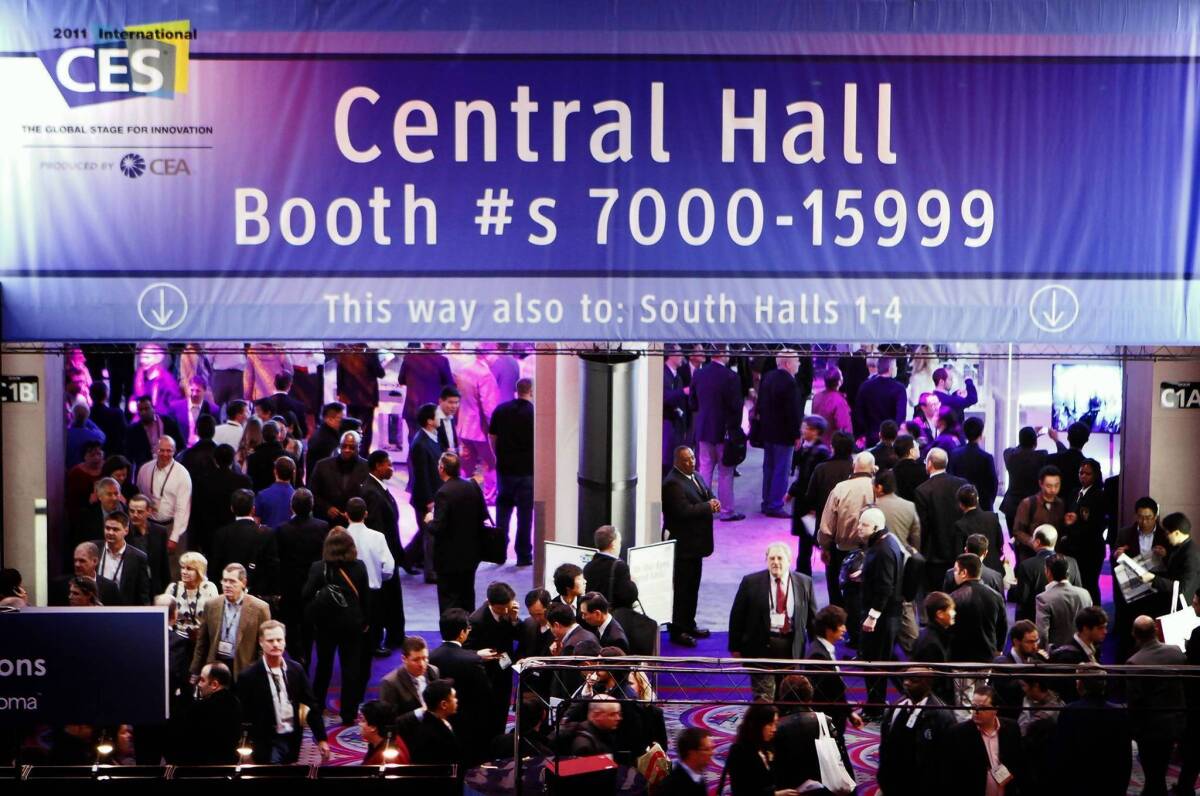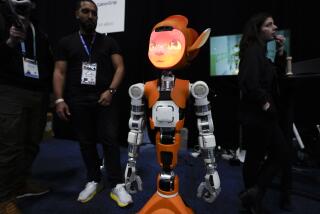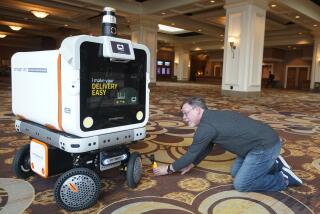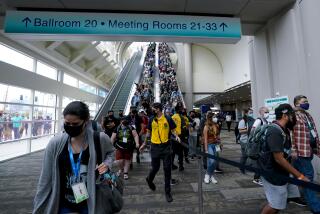At the Consumer Electronics Show, more glitz than gee whiz

The International Consumer Electronics Show next week may be facing questions about its relevance in an Internet world that makes new things seem old in minutes, but it is still the foremost gathering for all things gadgety and geeky.
The annual trade show in Las Vegas has a rich past showcasing such groundbreaking devices as the VCR, the CD player, the camcorder, high-definition television and the Blu-ray disc.
“It was the singular most important technology event of the year,” said Zack Zalon, a longtime show attendee and managing partner at the digital product design firm Wilshire Axon in Westwood.
The nature of the glitzy show has shifted in recent years from a focus on new products to one on deal-making and industry schmoozing. Still, the show draws enormous crowds and global publicity — even though the convention isn’t open to the public.
When it kicks off Tuesday, more than 3,200 exhibitors are expected to occupy 1.9 million square feet of
exhibition space at the convention center for four days of news conferences, product demonstrations, parties and celebrity appearances. Roughly 150,000 people, about the same as last year, are expected to attend, temporarily swelling the city’s population by about 25%.
These days, attendees and exhibitors say they see the show as a time to survey the overall personal electronics landscape and to connect in person with developers, retailers and the media.
Executives at the Beats by Dr. Dre line of high-end headphones, for instance, will be in Las Vegas but plan to hold their meetings and product demonstrations in exclusive suites on the Strip instead of vying for attention in the cavernous exhibit halls of the convention center.
“The brand experience that we want our customers and partners to have with Beats is very personal and it takes a real dialogue,” Beats President Luke Wood said. “I want to do that in an atmosphere that is personal and not rushed.”
New products will still be launched, preserving a bit of the show’s famous wow factor. Show producers say they expect 20,000 new products to be unveiled, including Samsung Electronics Co.’s 85-inch ultra-high-definition TV and LG Electronics’ newest organic-LED sets.
But groundbreaking products are rarely launched at the show anymore because of the 24-hour news cycle of the Internet, which makes it easy for companies to promote whatever they want, whenever they want.
Tech behemoths now accustomed to holding their own media events throughout the year don’t want to share the limelight with their rivals. Case in point: Microsoft Corp., which unveiled its Xbox video game console at the trade show in 2001, will not host a booth at the show this year nor give its usual keynote address.
Apple Inc., Google Inc. and Amazon.com Inc. don’t officially participate in the show, though they typically send executives and other employees to scope out the competition and meet quietly with developers and the media.
Part of the problem with the show is it’s “so huge that’s it’s tough for any announcement to gain any kind of traction,” said Zalon of Wilshire Axon.
“I don’t think anyone is going to CES under the illusion that they’re going to be dramatically educated on the innovations of the near future,” he said. “I think most people now go for face time and to hope to pick up on some trends that indicate where things are heading.”
Exhibitors are expected to focus on improvements to already-established technologies, emphasizing the fast-growing markets for tablets and smartphones and related products.
Many of the devices and technologies featured at the show will begin appearing on store shelves in the weeks following the event.
With the television industry in a slump and projected to have a flat sales year in 2013, TV manufacturers will be out in force at the show. Many will be touting larger screen sizes as consumers increasingly adopt a bigger-is-better approach when buying TVs.
Samsung will have one of the largest booth spaces at the show, where it will display the 85-inch ultra-HDTV, one of the largest commercially available “4K” sets to hit the market this year. The so-called 4K TVs cram four times as much picture information onto the screen as current high-definition models do.
Samsung also will demonstrate a smart TV camera with features such as gesture control and face recognition, as well as an improved Smart Hub platform for Internet-connected televisions.
“It’s an evolution in terms of the way consumers can access and manage their content,” said Dave Das, vice president of television marketing at Samsung Electronics America. “The main thing is it’s simplified, it’s a much more intuitive interface. People will find it much easier to use than what we’ve done before.”
Tim Alessi, director of new product development for LG Electronics, said the company planned to have an expanded lineup of 4K sets and would also feature its newest organic-LED sets at the show, which LG hopes to start selling by the end of March.
“CES is the perfect time to really lay out what our vision for the year is,” Alessi said.
Tablets are expected to be one of the dominant themes at this year’s event, said Shawn DuBravac, chief economist for the Consumer Electronics Assn., which owns and produces the show. In less than three years on the market, the Apple iPad has transformed the computing industry.
There were 31.9 million tablets shipped in the U.S. in 2011. That number is expected to jump to 119.9 million annually in 2014. That’s bad news for just about every other category of computing: The association estimates that laptop sales will rise only by 5.4 million annually by 2014 and predicts that desktop and netbook sales will decline.
Now that 1 out of 3 U.S. households has a tablet, DuBravac said, just about every company at the show will be demonstrating how it is trying to take advantage of that growing user base.
Much of the focus will be on apps, which have exploded in popularity after the launch of the iPhone in 2007. Indeed, the iLounge at the show, which focuses on apps and developers, will be four times larger this year than it was three years ago, DuBravac said.
Companies will also be displaying products that help users connect new devices to their existing gadgets and let them share content and data across platforms, DuBravac said.
Quirky technologies will also be prominent. Among them are a mobile health app that monitors stress levels, an Android app that predicts what users meant to type so they won’t need to look at their touch screens when writing a message and a Wi-Fi video monitoring camera that enables users to spy on their pets and kids from afar.
More to Read
Inside the business of entertainment
The Wide Shot brings you news, analysis and insights on everything from streaming wars to production — and what it all means for the future.
You may occasionally receive promotional content from the Los Angeles Times.











